Healthcare Reform, Nursing Practice, and Future Trends Analysis
VerifiedAdded on 2022/08/21
|7
|1598
|21
Report
AI Summary
This report examines the Affordable Care Act and the American Health Act, outlining healthcare reform efforts in the US. It explores the impact of quality measures and pay-for-performance on patient outcomes and nursing practice, including the expectations and responsibilities of nurses in these situations. The report further discusses professional nursing leadership and management roles that have arisen in response to emerging trends, focusing on promoting patient safety and quality care in diverse healthcare settings. Finally, it predicts how nursing practice and roles will evolve in the next five years in response to upcoming trends and predicted issues in healthcare, such as technological advancements and globalization.
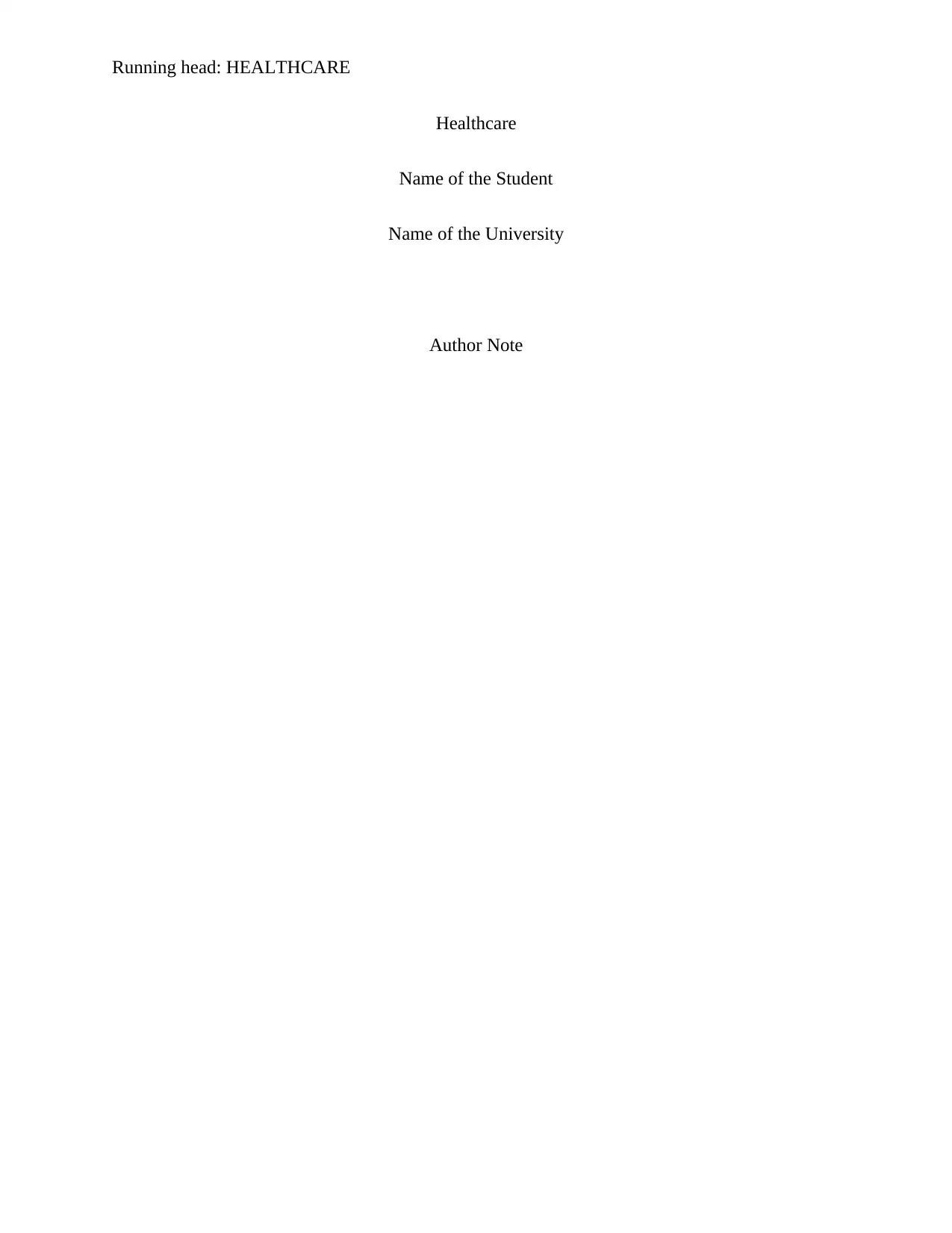
Running head: HEALTHCARE
Healthcare
Name of the Student
Name of the University
Author Note
Healthcare
Name of the Student
Name of the University
Author Note
Paraphrase This Document
Need a fresh take? Get an instant paraphrase of this document with our AI Paraphraser
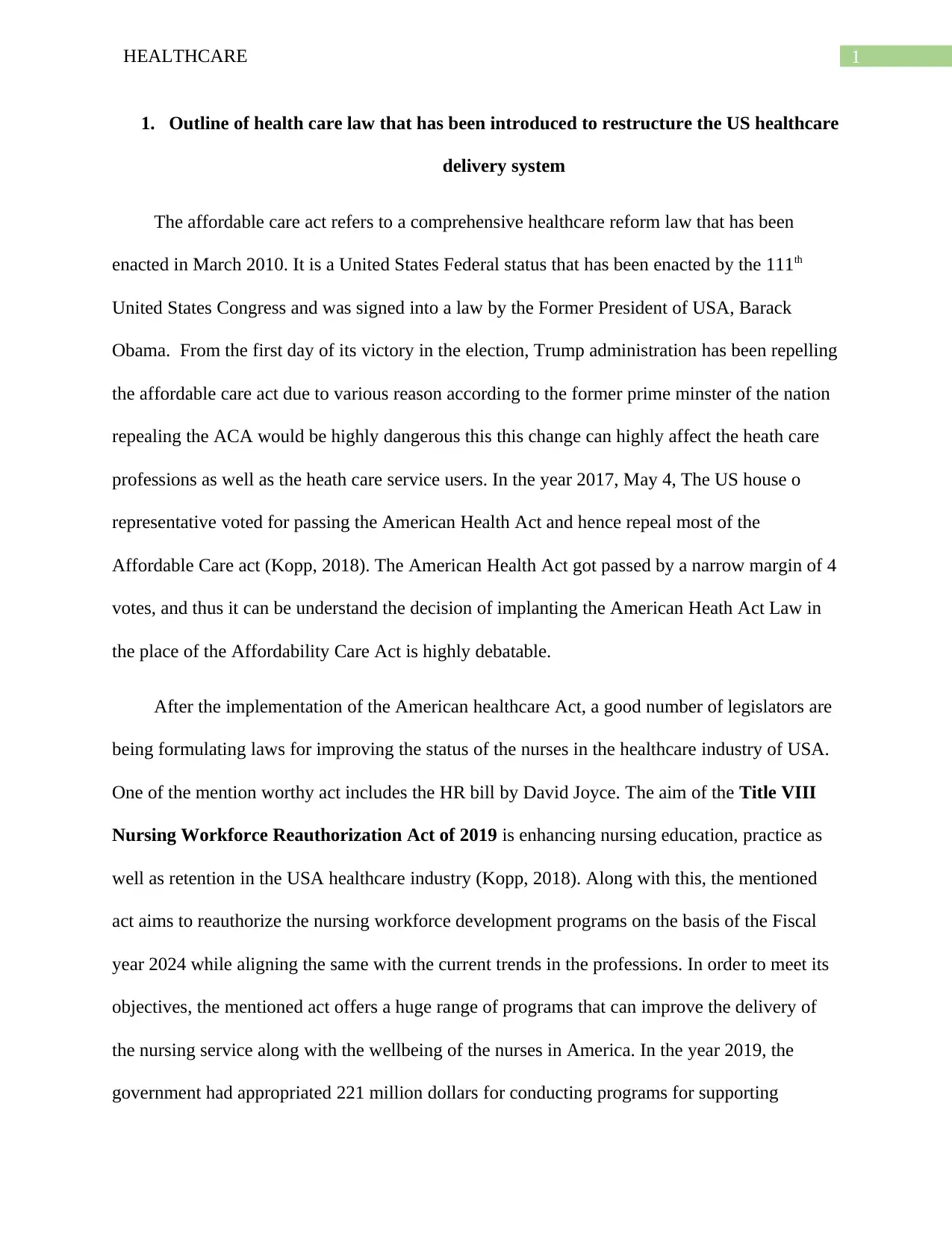
1HEALTHCARE
1. Outline of health care law that has been introduced to restructure the US healthcare
delivery system
The affordable care act refers to a comprehensive healthcare reform law that has been
enacted in March 2010. It is a United States Federal status that has been enacted by the 111th
United States Congress and was signed into a law by the Former President of USA, Barack
Obama. From the first day of its victory in the election, Trump administration has been repelling
the affordable care act due to various reason according to the former prime minster of the nation
repealing the ACA would be highly dangerous this this change can highly affect the heath care
professions as well as the heath care service users. In the year 2017, May 4, The US house o
representative voted for passing the American Health Act and hence repeal most of the
Affordable Care act (Kopp, 2018). The American Health Act got passed by a narrow margin of 4
votes, and thus it can be understand the decision of implanting the American Heath Act Law in
the place of the Affordability Care Act is highly debatable.
After the implementation of the American healthcare Act, a good number of legislators are
being formulating laws for improving the status of the nurses in the healthcare industry of USA.
One of the mention worthy act includes the HR bill by David Joyce. The aim of the Title VIII
Nursing Workforce Reauthorization Act of 2019 is enhancing nursing education, practice as
well as retention in the USA healthcare industry (Kopp, 2018). Along with this, the mentioned
act aims to reauthorize the nursing workforce development programs on the basis of the Fiscal
year 2024 while aligning the same with the current trends in the professions. In order to meet its
objectives, the mentioned act offers a huge range of programs that can improve the delivery of
the nursing service along with the wellbeing of the nurses in America. In the year 2019, the
government had appropriated 221 million dollars for conducting programs for supporting
1. Outline of health care law that has been introduced to restructure the US healthcare
delivery system
The affordable care act refers to a comprehensive healthcare reform law that has been
enacted in March 2010. It is a United States Federal status that has been enacted by the 111th
United States Congress and was signed into a law by the Former President of USA, Barack
Obama. From the first day of its victory in the election, Trump administration has been repelling
the affordable care act due to various reason according to the former prime minster of the nation
repealing the ACA would be highly dangerous this this change can highly affect the heath care
professions as well as the heath care service users. In the year 2017, May 4, The US house o
representative voted for passing the American Health Act and hence repeal most of the
Affordable Care act (Kopp, 2018). The American Health Act got passed by a narrow margin of 4
votes, and thus it can be understand the decision of implanting the American Heath Act Law in
the place of the Affordability Care Act is highly debatable.
After the implementation of the American healthcare Act, a good number of legislators are
being formulating laws for improving the status of the nurses in the healthcare industry of USA.
One of the mention worthy act includes the HR bill by David Joyce. The aim of the Title VIII
Nursing Workforce Reauthorization Act of 2019 is enhancing nursing education, practice as
well as retention in the USA healthcare industry (Kopp, 2018). Along with this, the mentioned
act aims to reauthorize the nursing workforce development programs on the basis of the Fiscal
year 2024 while aligning the same with the current trends in the professions. In order to meet its
objectives, the mentioned act offers a huge range of programs that can improve the delivery of
the nursing service along with the wellbeing of the nurses in America. In the year 2019, the
government had appropriated 221 million dollars for conducting programs for supporting
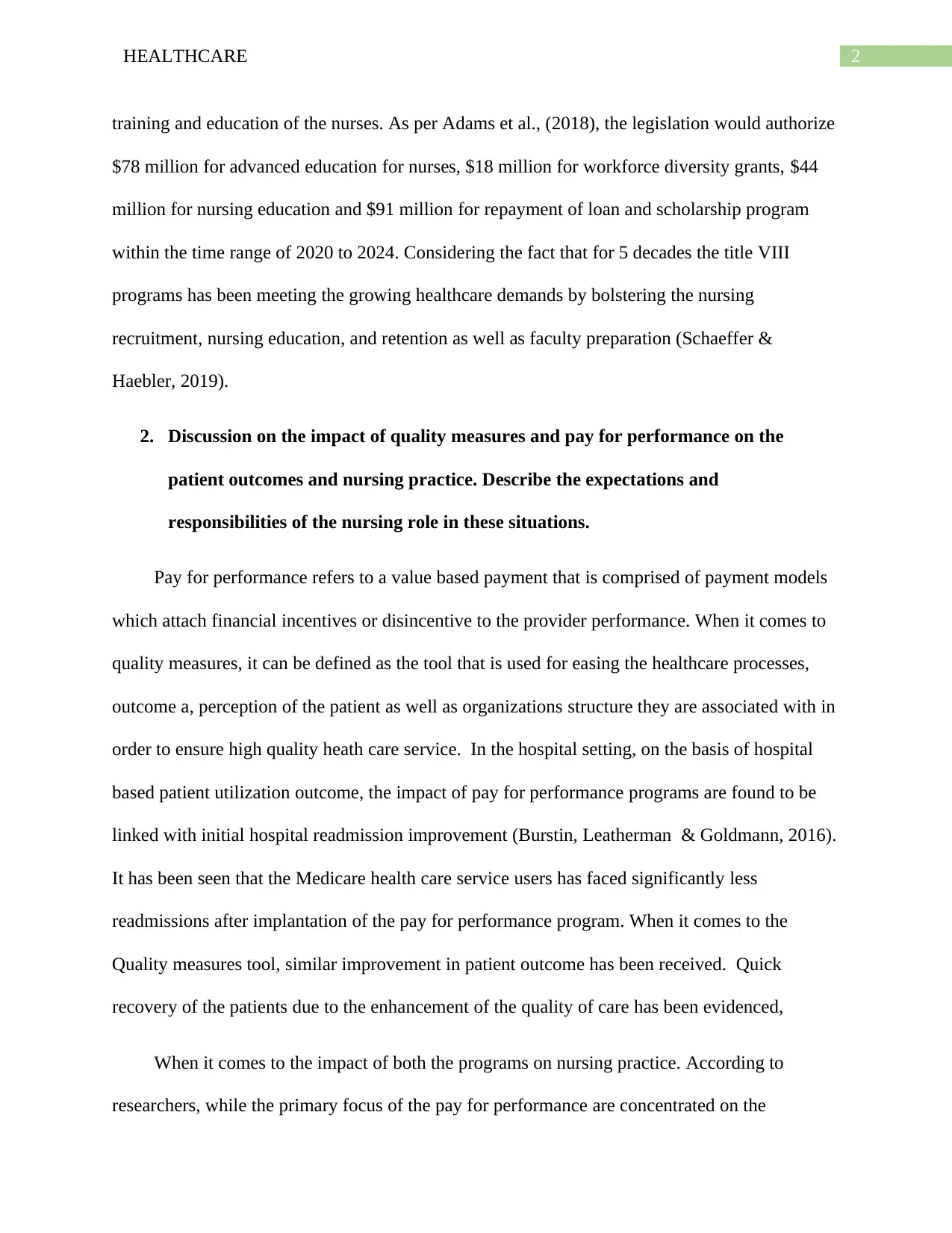
2HEALTHCARE
training and education of the nurses. As per Adams et al., (2018), the legislation would authorize
$78 million for advanced education for nurses, $18 million for workforce diversity grants, $44
million for nursing education and $91 million for repayment of loan and scholarship program
within the time range of 2020 to 2024. Considering the fact that for 5 decades the title VIII
programs has been meeting the growing healthcare demands by bolstering the nursing
recruitment, nursing education, and retention as well as faculty preparation (Schaeffer &
Haebler, 2019).
2. Discussion on the impact of quality measures and pay for performance on the
patient outcomes and nursing practice. Describe the expectations and
responsibilities of the nursing role in these situations.
Pay for performance refers to a value based payment that is comprised of payment models
which attach financial incentives or disincentive to the provider performance. When it comes to
quality measures, it can be defined as the tool that is used for easing the healthcare processes,
outcome a, perception of the patient as well as organizations structure they are associated with in
order to ensure high quality heath care service. In the hospital setting, on the basis of hospital
based patient utilization outcome, the impact of pay for performance programs are found to be
linked with initial hospital readmission improvement (Burstin, Leatherman & Goldmann, 2016).
It has been seen that the Medicare health care service users has faced significantly less
readmissions after implantation of the pay for performance program. When it comes to the
Quality measures tool, similar improvement in patient outcome has been received. Quick
recovery of the patients due to the enhancement of the quality of care has been evidenced,
When it comes to the impact of both the programs on nursing practice. According to
researchers, while the primary focus of the pay for performance are concentrated on the
training and education of the nurses. As per Adams et al., (2018), the legislation would authorize
$78 million for advanced education for nurses, $18 million for workforce diversity grants, $44
million for nursing education and $91 million for repayment of loan and scholarship program
within the time range of 2020 to 2024. Considering the fact that for 5 decades the title VIII
programs has been meeting the growing healthcare demands by bolstering the nursing
recruitment, nursing education, and retention as well as faculty preparation (Schaeffer &
Haebler, 2019).
2. Discussion on the impact of quality measures and pay for performance on the
patient outcomes and nursing practice. Describe the expectations and
responsibilities of the nursing role in these situations.
Pay for performance refers to a value based payment that is comprised of payment models
which attach financial incentives or disincentive to the provider performance. When it comes to
quality measures, it can be defined as the tool that is used for easing the healthcare processes,
outcome a, perception of the patient as well as organizations structure they are associated with in
order to ensure high quality heath care service. In the hospital setting, on the basis of hospital
based patient utilization outcome, the impact of pay for performance programs are found to be
linked with initial hospital readmission improvement (Burstin, Leatherman & Goldmann, 2016).
It has been seen that the Medicare health care service users has faced significantly less
readmissions after implantation of the pay for performance program. When it comes to the
Quality measures tool, similar improvement in patient outcome has been received. Quick
recovery of the patients due to the enhancement of the quality of care has been evidenced,
When it comes to the impact of both the programs on nursing practice. According to
researchers, while the primary focus of the pay for performance are concentrated on the
⊘ This is a preview!⊘
Do you want full access?
Subscribe today to unlock all pages.

Trusted by 1+ million students worldwide
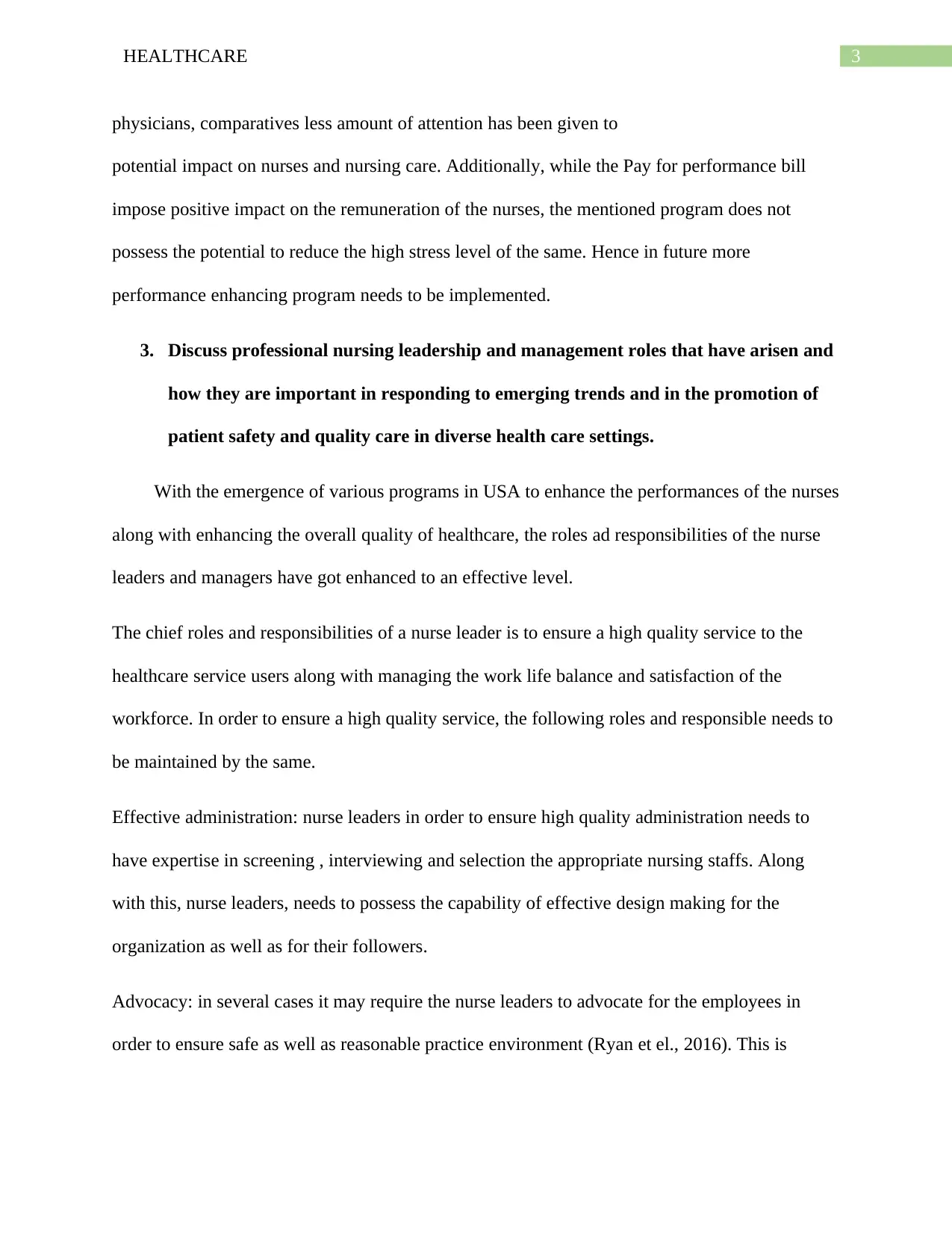
3HEALTHCARE
physicians, comparatives less amount of attention has been given to
potential impact on nurses and nursing care. Additionally, while the Pay for performance bill
impose positive impact on the remuneration of the nurses, the mentioned program does not
possess the potential to reduce the high stress level of the same. Hence in future more
performance enhancing program needs to be implemented.
3. Discuss professional nursing leadership and management roles that have arisen and
how they are important in responding to emerging trends and in the promotion of
patient safety and quality care in diverse health care settings.
With the emergence of various programs in USA to enhance the performances of the nurses
along with enhancing the overall quality of healthcare, the roles ad responsibilities of the nurse
leaders and managers have got enhanced to an effective level.
The chief roles and responsibilities of a nurse leader is to ensure a high quality service to the
healthcare service users along with managing the work life balance and satisfaction of the
workforce. In order to ensure a high quality service, the following roles and responsible needs to
be maintained by the same.
Effective administration: nurse leaders in order to ensure high quality administration needs to
have expertise in screening , interviewing and selection the appropriate nursing staffs. Along
with this, nurse leaders, needs to possess the capability of effective design making for the
organization as well as for their followers.
Advocacy: in several cases it may require the nurse leaders to advocate for the employees in
order to ensure safe as well as reasonable practice environment (Ryan et el., 2016). This is
physicians, comparatives less amount of attention has been given to
potential impact on nurses and nursing care. Additionally, while the Pay for performance bill
impose positive impact on the remuneration of the nurses, the mentioned program does not
possess the potential to reduce the high stress level of the same. Hence in future more
performance enhancing program needs to be implemented.
3. Discuss professional nursing leadership and management roles that have arisen and
how they are important in responding to emerging trends and in the promotion of
patient safety and quality care in diverse health care settings.
With the emergence of various programs in USA to enhance the performances of the nurses
along with enhancing the overall quality of healthcare, the roles ad responsibilities of the nurse
leaders and managers have got enhanced to an effective level.
The chief roles and responsibilities of a nurse leader is to ensure a high quality service to the
healthcare service users along with managing the work life balance and satisfaction of the
workforce. In order to ensure a high quality service, the following roles and responsible needs to
be maintained by the same.
Effective administration: nurse leaders in order to ensure high quality administration needs to
have expertise in screening , interviewing and selection the appropriate nursing staffs. Along
with this, nurse leaders, needs to possess the capability of effective design making for the
organization as well as for their followers.
Advocacy: in several cases it may require the nurse leaders to advocate for the employees in
order to ensure safe as well as reasonable practice environment (Ryan et el., 2016). This is
Paraphrase This Document
Need a fresh take? Get an instant paraphrase of this document with our AI Paraphraser
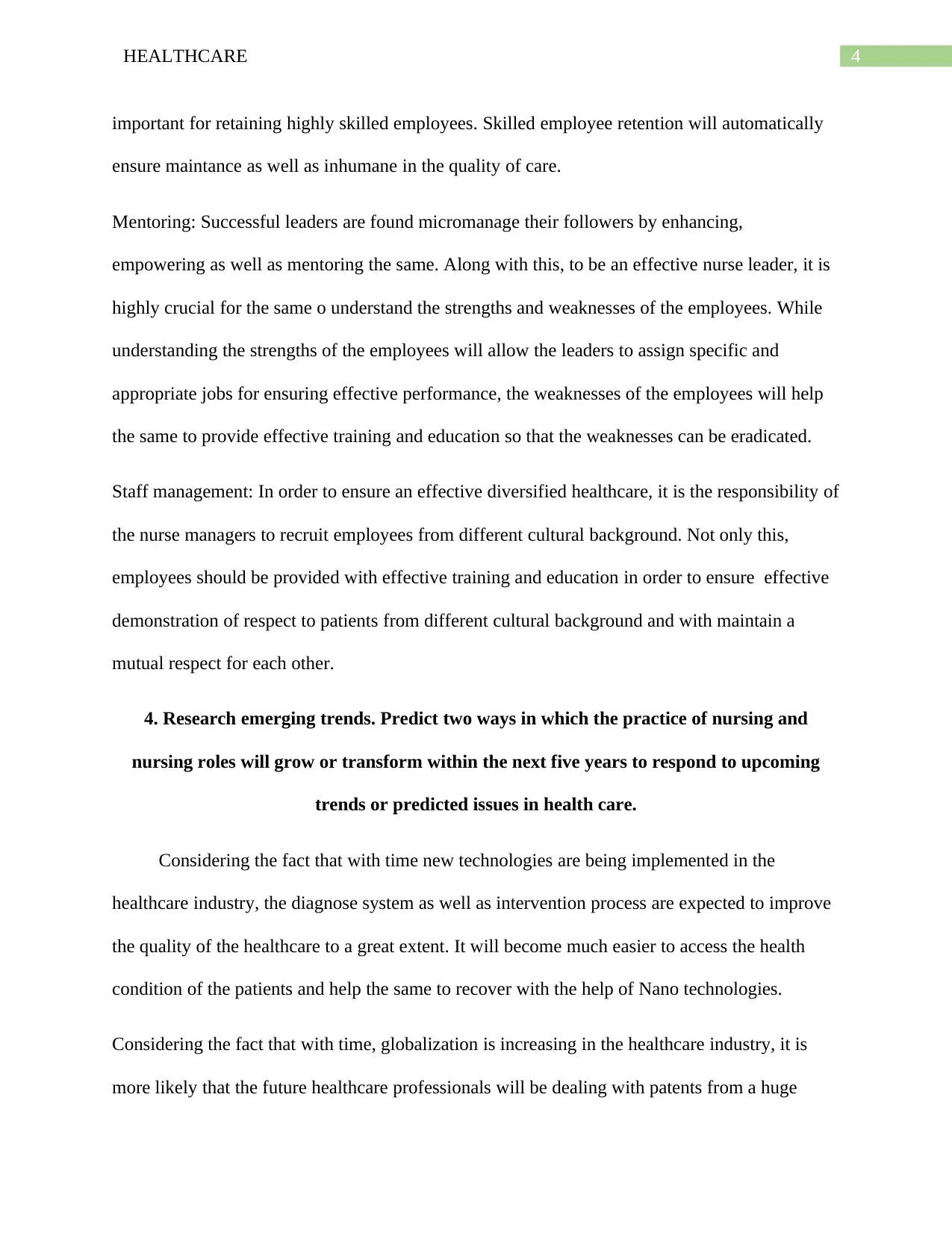
4HEALTHCARE
important for retaining highly skilled employees. Skilled employee retention will automatically
ensure maintance as well as inhumane in the quality of care.
Mentoring: Successful leaders are found micromanage their followers by enhancing,
empowering as well as mentoring the same. Along with this, to be an effective nurse leader, it is
highly crucial for the same o understand the strengths and weaknesses of the employees. While
understanding the strengths of the employees will allow the leaders to assign specific and
appropriate jobs for ensuring effective performance, the weaknesses of the employees will help
the same to provide effective training and education so that the weaknesses can be eradicated.
Staff management: In order to ensure an effective diversified healthcare, it is the responsibility of
the nurse managers to recruit employees from different cultural background. Not only this,
employees should be provided with effective training and education in order to ensure effective
demonstration of respect to patients from different cultural background and with maintain a
mutual respect for each other.
4. Research emerging trends. Predict two ways in which the practice of nursing and
nursing roles will grow or transform within the next five years to respond to upcoming
trends or predicted issues in health care.
Considering the fact that with time new technologies are being implemented in the
healthcare industry, the diagnose system as well as intervention process are expected to improve
the quality of the healthcare to a great extent. It will become much easier to access the health
condition of the patients and help the same to recover with the help of Nano technologies.
Considering the fact that with time, globalization is increasing in the healthcare industry, it is
more likely that the future healthcare professionals will be dealing with patents from a huge
important for retaining highly skilled employees. Skilled employee retention will automatically
ensure maintance as well as inhumane in the quality of care.
Mentoring: Successful leaders are found micromanage their followers by enhancing,
empowering as well as mentoring the same. Along with this, to be an effective nurse leader, it is
highly crucial for the same o understand the strengths and weaknesses of the employees. While
understanding the strengths of the employees will allow the leaders to assign specific and
appropriate jobs for ensuring effective performance, the weaknesses of the employees will help
the same to provide effective training and education so that the weaknesses can be eradicated.
Staff management: In order to ensure an effective diversified healthcare, it is the responsibility of
the nurse managers to recruit employees from different cultural background. Not only this,
employees should be provided with effective training and education in order to ensure effective
demonstration of respect to patients from different cultural background and with maintain a
mutual respect for each other.
4. Research emerging trends. Predict two ways in which the practice of nursing and
nursing roles will grow or transform within the next five years to respond to upcoming
trends or predicted issues in health care.
Considering the fact that with time new technologies are being implemented in the
healthcare industry, the diagnose system as well as intervention process are expected to improve
the quality of the healthcare to a great extent. It will become much easier to access the health
condition of the patients and help the same to recover with the help of Nano technologies.
Considering the fact that with time, globalization is increasing in the healthcare industry, it is
more likely that the future healthcare professionals will be dealing with patents from a huge
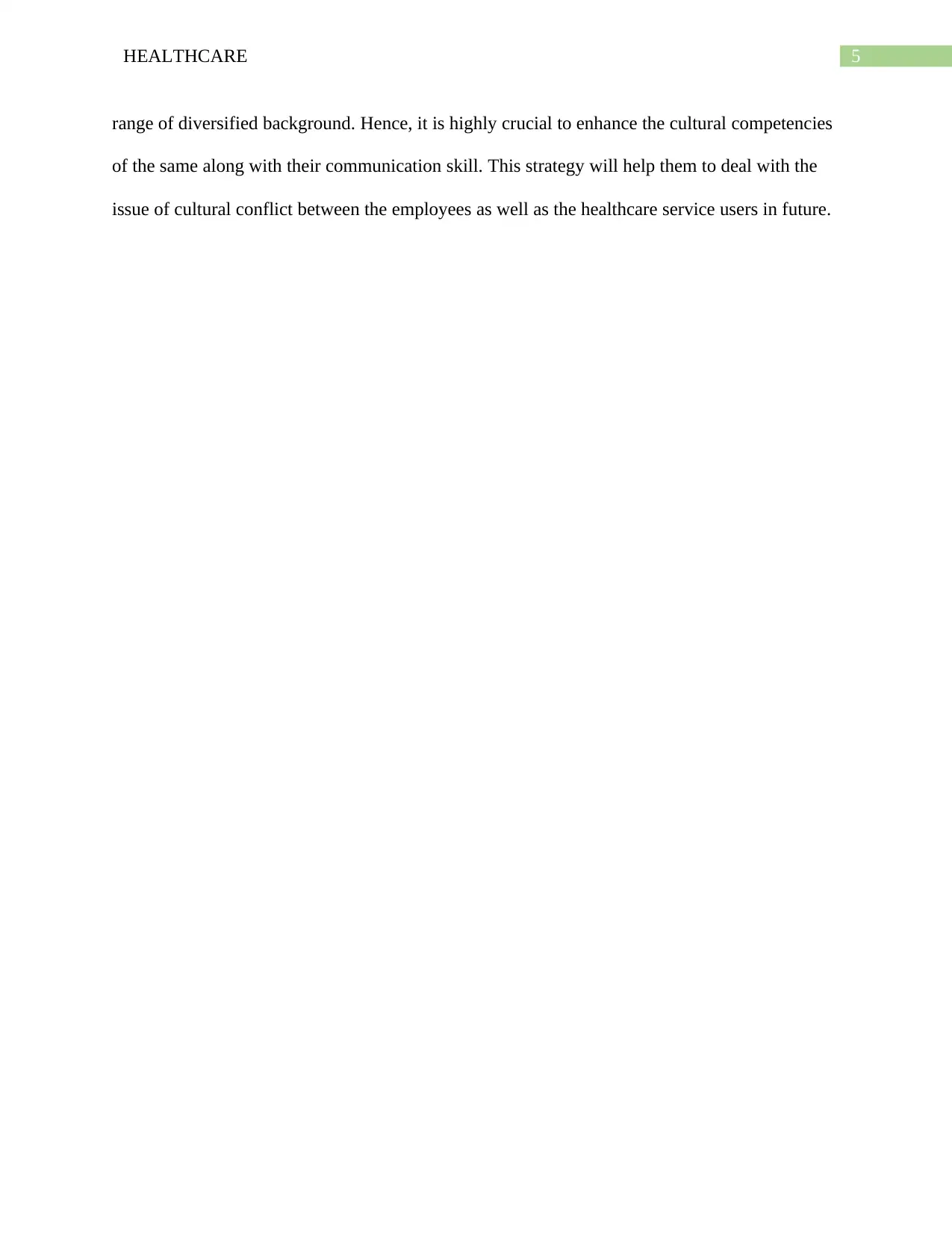
5HEALTHCARE
range of diversified background. Hence, it is highly crucial to enhance the cultural competencies
of the same along with their communication skill. This strategy will help them to deal with the
issue of cultural conflict between the employees as well as the healthcare service users in future.
range of diversified background. Hence, it is highly crucial to enhance the cultural competencies
of the same along with their communication skill. This strategy will help them to deal with the
issue of cultural conflict between the employees as well as the healthcare service users in future.
⊘ This is a preview!⊘
Do you want full access?
Subscribe today to unlock all pages.

Trusted by 1+ million students worldwide
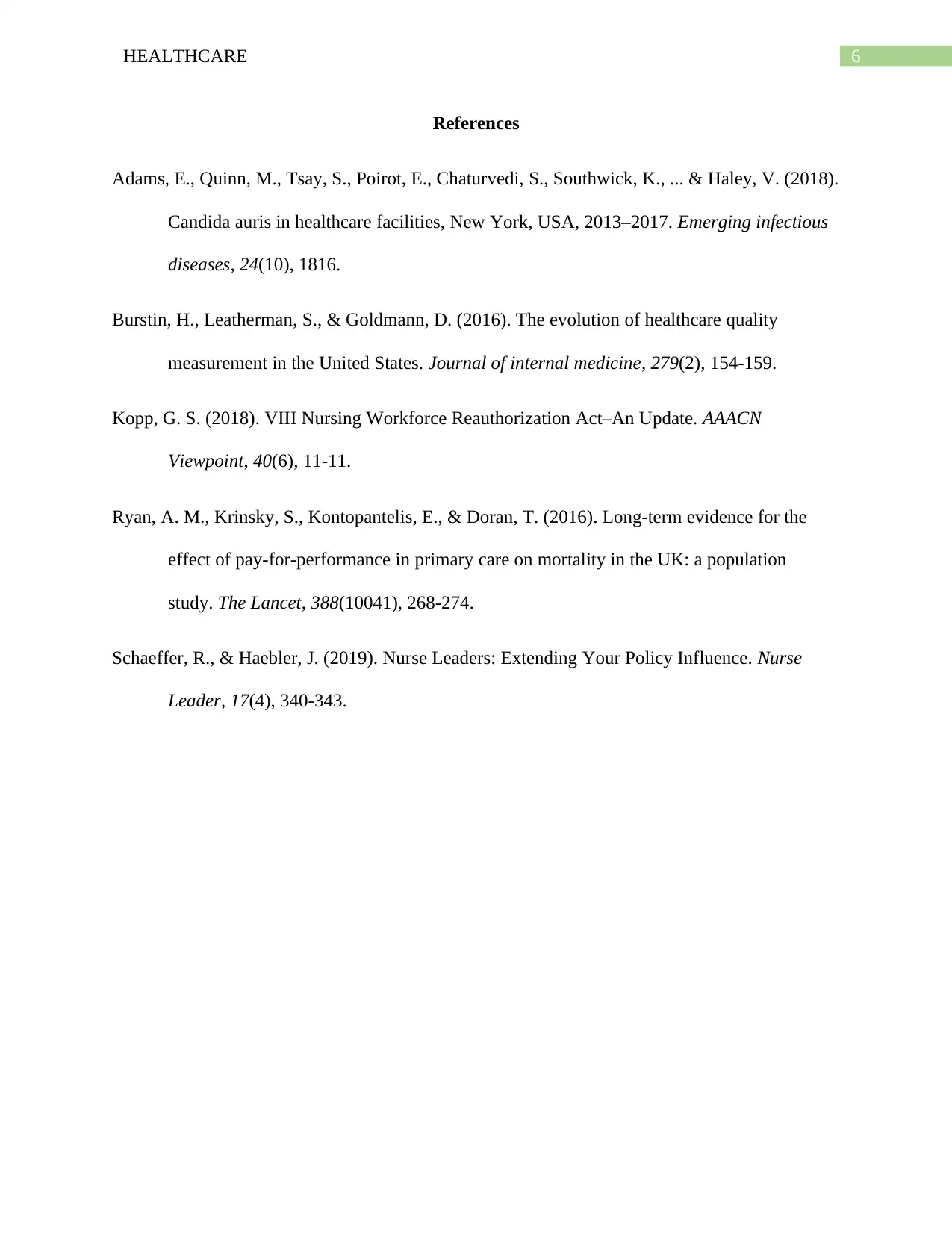
6HEALTHCARE
References
Adams, E., Quinn, M., Tsay, S., Poirot, E., Chaturvedi, S., Southwick, K., ... & Haley, V. (2018).
Candida auris in healthcare facilities, New York, USA, 2013–2017. Emerging infectious
diseases, 24(10), 1816.
Burstin, H., Leatherman, S., & Goldmann, D. (2016). The evolution of healthcare quality
measurement in the United States. Journal of internal medicine, 279(2), 154-159.
Kopp, G. S. (2018). VIII Nursing Workforce Reauthorization Act–An Update. AAACN
Viewpoint, 40(6), 11-11.
Ryan, A. M., Krinsky, S., Kontopantelis, E., & Doran, T. (2016). Long-term evidence for the
effect of pay-for-performance in primary care on mortality in the UK: a population
study. The Lancet, 388(10041), 268-274.
Schaeffer, R., & Haebler, J. (2019). Nurse Leaders: Extending Your Policy Influence. Nurse
Leader, 17(4), 340-343.
References
Adams, E., Quinn, M., Tsay, S., Poirot, E., Chaturvedi, S., Southwick, K., ... & Haley, V. (2018).
Candida auris in healthcare facilities, New York, USA, 2013–2017. Emerging infectious
diseases, 24(10), 1816.
Burstin, H., Leatherman, S., & Goldmann, D. (2016). The evolution of healthcare quality
measurement in the United States. Journal of internal medicine, 279(2), 154-159.
Kopp, G. S. (2018). VIII Nursing Workforce Reauthorization Act–An Update. AAACN
Viewpoint, 40(6), 11-11.
Ryan, A. M., Krinsky, S., Kontopantelis, E., & Doran, T. (2016). Long-term evidence for the
effect of pay-for-performance in primary care on mortality in the UK: a population
study. The Lancet, 388(10041), 268-274.
Schaeffer, R., & Haebler, J. (2019). Nurse Leaders: Extending Your Policy Influence. Nurse
Leader, 17(4), 340-343.
1 out of 7
Your All-in-One AI-Powered Toolkit for Academic Success.
+13062052269
info@desklib.com
Available 24*7 on WhatsApp / Email
![[object Object]](/_next/static/media/star-bottom.7253800d.svg)
Unlock your academic potential
Copyright © 2020–2025 A2Z Services. All Rights Reserved. Developed and managed by ZUCOL.
